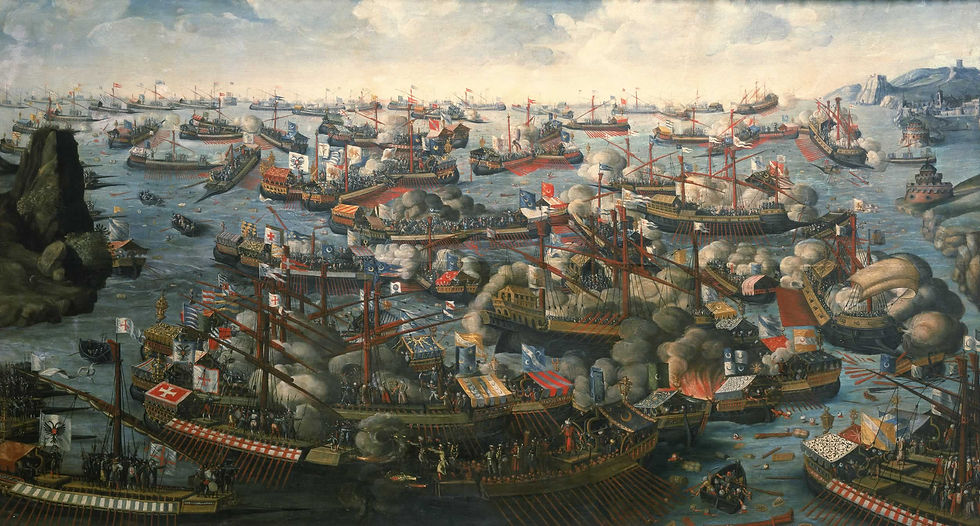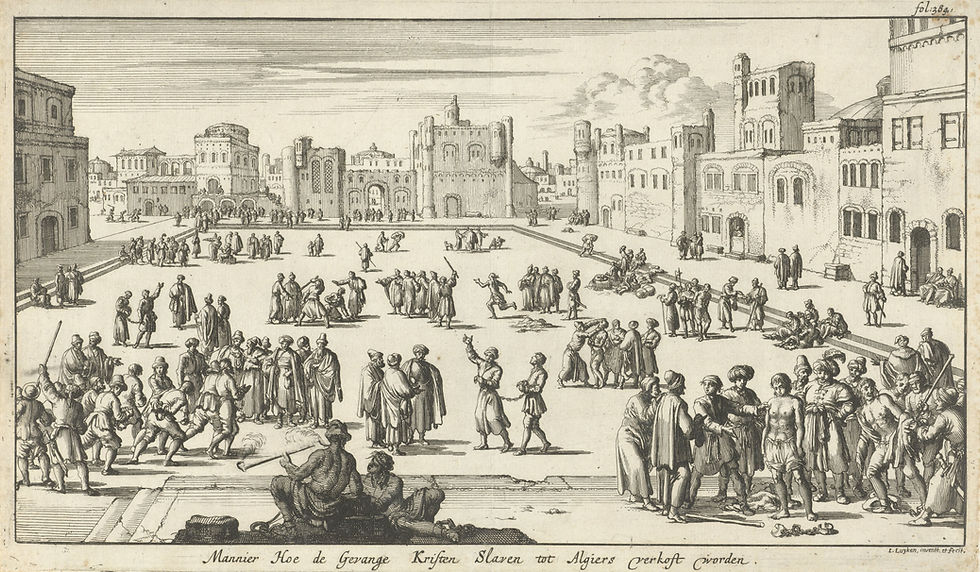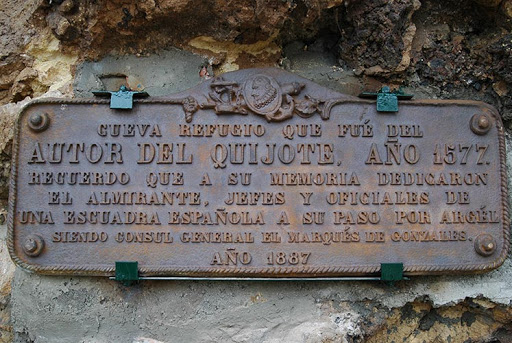About the Mediterranean, Catalonia, Cervantes, galleys and pirates (1/2)
- A. Jorge Aguilera López

- Oct 28, 2020
- 5 min read
Updated: Nov 17, 2020

The Battle of Lepanto, artist unknown [National Maritime Museum, Greenwich, London].
The Mediterranean of the Early Modern Age was a sea full of galleys. From the 16th century on, at each end of the Mediterranean, two opposing and confronted empires emerged: The Spanish Monarchy and the Ottoman Empire. Both tried to take control over the old Mare nostrum using huge galleys armadas. The galley was a ship mainly propelled by rowing, of antique origin, but capable to quickly be adapted to the needs of the «military revolution», by modifying its design and thus incorporating the novel artillery. Simultaneously to that frontal war between those two empires, there was a permanent war of attrition, much more effective and damaging. That other small-scale parallel war was waged by privateers and pirates, both Muslim and Christian, attacking the coasts and the trade routes of their opposites.
In this war of attrition, the disorganized North Africa proved far more effective than the Christian territories. From different enclaves on the Barbary coast, such as Algiers, Tunis or Tripoli, the different pirate city-states (most of them vassals of the Turkish Sultan), ruled by famous and feared lords such as Barbarossa or Dragut, continuously launched their attacks using galleys, galiots and fustas against the Christian Mediterranean. The current Spanish cities and enclaves in North Africa such as Ceuta, Melilla or El Peñón de los Vélez, are reminiscent of that past. There were many of these enclaves or «presidios», designed to act as the first line of defence or defensive shields against the privateers.

View of Bizerte (in Tunisia), 1613. Conquered in 1535 by Charles V, recovered by the Ottomans in 1574. Since then it became a corsair base. [General Archive of Simancas]
Catalonia was not spared this war. The documentation reveals a large number of attacks of this type. These are just a few examples to illustrate the situation. Thus on June 13, 1527:
At dawn, seventeen fustas of Moors arrived (…) before Badalona, where they killed four men and took more than twenty-five souls. And the viceroy with many people (…) went to [Sant Adrià de] Besòs, but the Moors were already returned and embarked on the galleys and fustas and, from them, they fired many artillery shots (…) and all seventeen passed before Barcelona without any opposition.
Or in 1553:
These days we have seen the Turks burn the villages of Palamós and Pineda and Malgrat and others. And today, many souls are in the power of the enemies of our Faith.
Or June 25, 1564:
This day at dawn, sixteen Moorish galiots came and landed at the head of the Besòs [river] and ran to Sant Adrià [de Besòs] and some houses in Badalona and burned part of Don Alzina de Badalona’s house and part of Father Setantí’s house (…) and they took three hundred and fifty-five rams from the farmyard of the butchers of the city and captured a woman and two boys and killed some young men, and alerted, they departed from the mouth of the Besòs and passed to the cape of Llobregat and were there until the afternoon.
Or on June 27, 1595, when the villages of Reus, Vilaseca, Masricart and La Canonja asked the Generalitat deputies for help:
For many years [these villages] have suffered great humiliation and damage from the Moors, Turks and corsairs (…), both at sea and on land, and they ordinarily rob and captivate us and do other enormous damage (…) and that's why nowadays most of that land is wasteland or is badly cultivated.
Robert C. Davis in his Christian Slaves, Muslim Masters: White Slavery in the Mediterranean, the Barbary Coast and Italy, 1500-1800, estimates –by extrapolating data– that between 1 and 1.25 million Christians were enslaved between 1530 and 1780. Not counting all the murdered and those who ended up abjuring their faith (and becoming pirates). There was a big business around the captives. Not only because of the slave business, but because there were religious organizations such as the Trinitarian Order or the Order of Mercy, which were actively dedicated to obtaining the sums of money requested by the captors and traveling to Barbary coast to buy the freedom of the Christian captives.

Christian prisoners sold as slaves in a square in Algiers, Jan Luyken, 1684 [Rijksmuseum]
That was the case of the famous writer Miguel de Cervantes. After having served as a soldier in Italy for a few years and having fought in the galleys against the Ottoman Empire, when he was returning to Spain aboard of a galley in 1575, he was captured along with his brother Rodrigo and many others on the Costa Brava (between Cadaqués and Palamós) by the Albanian renegade and privateer Arnaut Mami. Cervantes was taken to Algiers. Seeing the various recommendations that he carried, written in his favour to his good services by different generals, his captors considered that he was an important person and therefore asked a huge ransom for him. His relatives were unable to meet the requested amount and that is why he ended up spending five years in Algiers, which were a great influence on his later work. Cervantes tried to escape without success on different occasions. He was finally rescued by the Trinitarian priests in 1580, after collecting in extremis the money his captors asked for, since Cervantes was chained to a galley ready to go to Istanbul.
Cervantes took refuge in this cave in 1577 in one of his escape attempts. Today it is a small tourist attraction
[El País].
Not surprisingly, every victory against the Muslims was celebrated effusively throughout Christendom, especially in the areas where this war was suffered the most. On September 8, 1566, just the year after the successful great relief of Malta, a procession commemorating it was held in Barcelona:
On this day, there was a procession in the church of St John’s in the present city and a solemn office and sermon (…). And this entire celebration was held in memory of last year, on this day as Don García [from Toledo], captain general of the armada of our King and Lord, relieved the island of Malta with many people he brought, causing that both the army and the armada of the Turk fled. And in the commemoration of such great mercy that Our Lord made them on that day, the Grand Master has ordered that each year, on such day as today, a procession and solemn office and sermon be held through the houses of his Order, thanking Our Lord of the great favour that he made them on such day, keeping them to the said Order [of Malta], which can be said to be the key to Christianity.
To know more:
Braudel, Fernand. The Mediterranean and the Mediterranean World in the Age of Philip II (2 Vol.). Berkeley and Los Angeles: University of California Press, 1995.
Davis, Robert C. Christian Slaves, Muslim Masters: White Slavery in the Mediterranean, the Barbary Coast and Italy, 1500-1800. New York: Palgrave Macmillan, 2003.
Aguilera López, A. Jorge (2020) "About the Mediterranean, Catalonia, Cervantes, galleys and pirates (1/2)", in Rowing thorugh History [online].













Comments